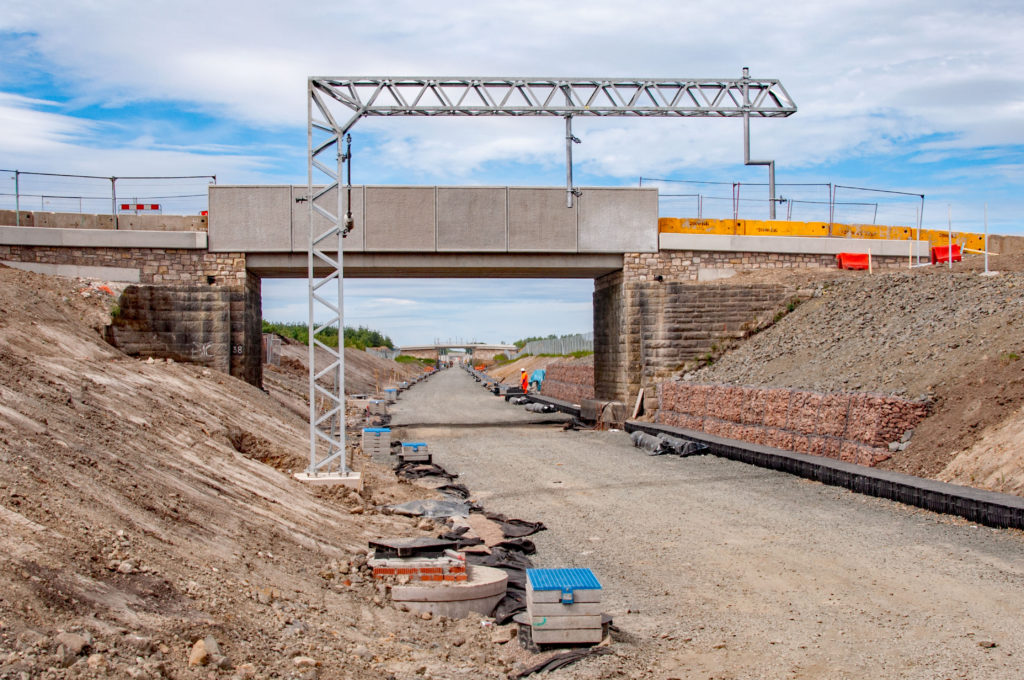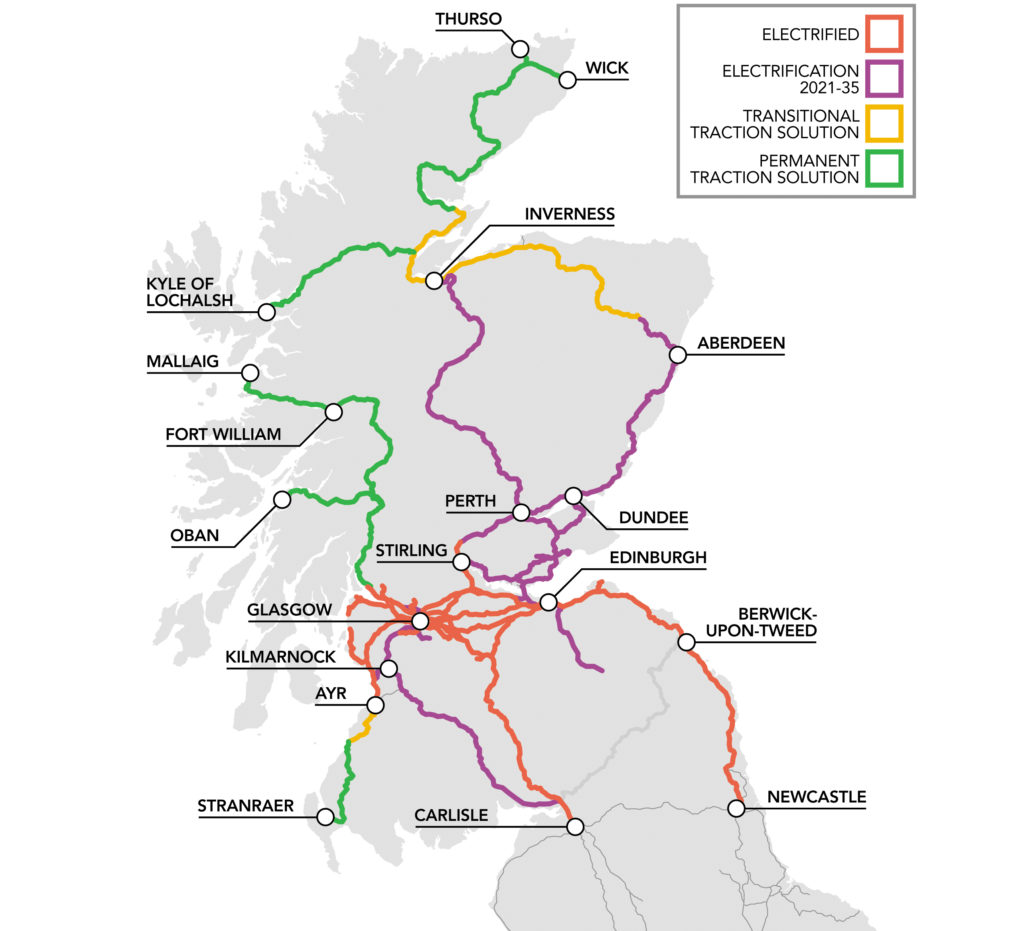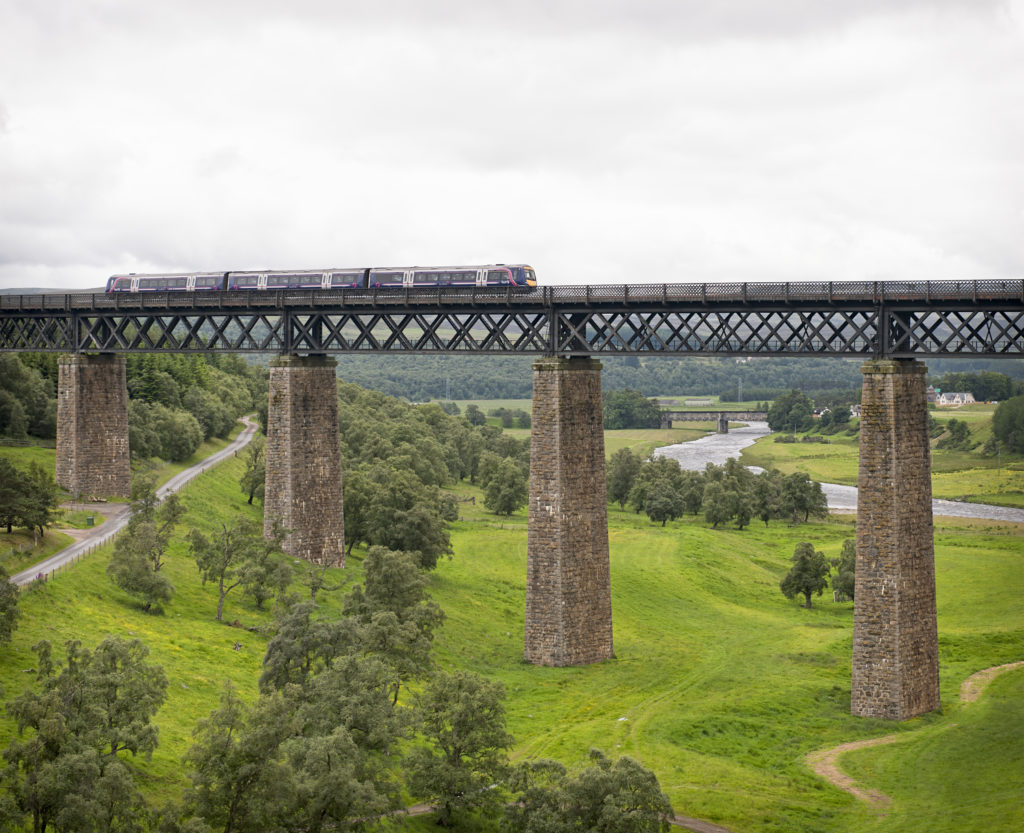Last July saw the publication of both Network Rail’s Traction Decarbonisation Network Strategy (TDNS) and the Scottish Government’s Rail Services Decarbonisation Action Plan. Both reports concluded that rail decarbonisation requires electrification of a large part of the unelectrified network, with battery or hydrogen traction used on a smaller proportion of lesser used lines.
The key difference between these reports is that the former was a recommendation (from the rail industry to the UK Government) whereas the latter was an instruction (from the Scottish Government to industry).
The UK Transport Decarbonisation Plan was to be published in Autumn 2020 but has yet to appear. The Scottish Government published its National Transport Strategy in February 2020 which contains its vision for a sustainable, inclusive, safe and accessible transport system. The delivery of this vision was explained at a recent virtual event organised by the IMechE’s Railway Division in Scotland which specifically considered rail decarbonisation.
At this event Bill Reeve, Transport Scotland’s Director of Rail, Alex Hynes, Managing Director, Scotland’s Railway, Syeda Ghufran, ScotRail’s Engineering Director and Katie Vollbracht, Principal Programme Sponsor for Network Rail Scotland, explained how the programme to give Scotland a zero-carbon railway by 2035 is being delivered.

Scotland’s net-zero transport story
Bill Reeve opened the event by referring to the vision in the Scottish National Transport Strategy for a sustainable, inclusive, safe and accessible transport system that reduces inequalities, takes climate action, delivers inclusive growth and improves health and wellbeing, and how these objectives are interlinked. For example, better decarbonised public transport reduces both carbon and harmful diesel emissions, and encourages people to walk and cycle. He explained how the strategy guides policy and investment decisions with a transport hierarchy of walking, cycling, public transport, taxis and shared transport, and car.
In Scotland, transport accounts for 37% of all greenhouse gas emissions. Of this, cars, vans, and HGVs account for 65%, air and shipping 30%, with buses and rail accounting for 3.2% and 1.2% respectively. On the roads, Scotland plans to phase out new petrol and diesel cars by 2032, introduce low emission zones and accelerate the deployment of zero-emission buses across Scotland. It also aims to decarbonise flights within Scotland by 2040.
As rail has such a low emission share, Bill noted that it might be thought that action to decarbonise rail was not a priority. Yet, as he pointed out, zero transport emissions is unlikely to be possible without some measure of modal shift to get people and goods off the roads. Freight decarbonisation requires a differently-managed logistics distribution system which takes goods out of HGVs and light vans onto a decarbonised rail network. This requires more rail electrification.
Since 2010, Scotland has delivered over 500 single-track kilometres (stk) of electrification. This started with the new Airdrie-Bathgate railway which opened in 2010 and was followed by Paisley Canal, Cumbernauld, the Edinburgh-Glasgow main line, Stirling-Dunblane/Alloa and Shotts. Work has now started on the East Kilbride and Barrhead schemes. Bill stressed the importance of keeping electrification costs down and notes that Scotland’s rolling programme has enabled teams to ‘learn as they do’ which is a good way of driving down costs.
He emphasised that railway costs have to be kept down to ensure the overall sustainability of the railway business. In this respect, electrification was not just about the environment. Electric trains cost less to buy and run, are faster and attract more passengers. They also enable longer freight trains to be run at higher speeds, resulting in more trains on existing infrastructure.
Bill noted that he is often asked how Scotland can afford to electrify its network, to which his answer is that we simply can’t afford not to.


Whole system approach
Network Rail Scotland’s Principal Programme Sponsor, Katie Vollbracht, emphasised that delivering rail decarbonisation requires a fully integrated approach to the whole railway system to provide the required infrastructure and rolling stock to meet enhanced timetable requirements by 2035. Such timetables will be needed to accommodate and attract passengers and goods to drive the required modal shift for Scotland’s decarbonisation programme.
This needs more reliable and quicker trains, as well as more paths and a gauge clearance programme for freight. She advised that the whole pipeline for rail investment in Scotland supports these goals for which route strategies were considering all options.
These strategies are looking at infrastructure enhancements to be done prior to electrification such as freight loops, gauge clearance and signalling. All options are being examined to achieve full electrification, including discontinuous electrification as a transitional strategy. This has to take account of the future availability of rolling stock, such as Battery Electric Multiple Units (BEMUs) and the timescales and locations for electrical feeder stations. Feasibility work is considering the timing and order of the required route enhancements and electrification.
Katie advised that the short-term priorities over the next five years are the electrification of the East Kilbride and Barrhead lines, and eliminating diesel traction on the Borders and Fife lines. The heavily graded 30-mile Borders Railway is too far for BEMU operation and was built with passive provision for electrification, though may initially have partial electrification with BEMUs. One option for Fife is electrification of the main line to Dundee, with BEMUs operating on the Fife Circle and the new Levenmouth branch which is due to open in 2024. In the longer term, options for routes to Inverness and Aberdeen depend on the availability of rolling stock.

Scotland’s plan to decarbonise its railway requires 1,800 single-track kilometres of electrification, with 18 feeder stations and 30 track sectioning cabinets. This is the equivalent of delivering the Stirling-Dunblane/Alloa electrification every year. There are also 560 potential bridge reconstructions. Contracts have already been let for East Kilbride, Barrhead, Maryhill, Borders, Fife, Kilmarnock and Dunblane-Perth (400 stk); the Fife lines are out to tender (165 stk) and the Perth-Aberdeen remit (350 stk) is being prepared.

Katie acknowledged that integrating infrastructure, rolling stock and timetable requirements is a bold programme with many challenges. It requires everyone to be adaptable, efficient, and quicker when developing and delivering schemes, and to take full advantage of innovations, particularly those offering more cost-effective electrification. Procurement is also a huge challenge for both infrastructure and rolling stock, although it offers huge opportunities for the supply chain and the economy.
Replacing the diesels
ScotRail’s Engineering Director, Syeda Ghufran, described the number for diesel units that will be life-expired within the next 10-15 years. These are 43x Class 156 (2026), 40x Class 158 (2030), 25x HSTs (2030) and 34x Class 170 (2035).
She advised that ScotRail is developing a fleet strategy in conjunction with Transport Scotland and Network Rail which will set out plans to replace diesel traction on routes being electrified. This will also consider alternative green traction to decarbonise certain routes ahead of full electrification and also on routes where there is not an economic business case for full electrification, such as the Far North and West Highland lines.
This is focusing on the introduction of an electric fleet coupled with targeted battery and hydrogen technology. Its scale is quite significant as not only are there 142 diesel units to be replaced, but 55x Class 318/320 EMUs operating on the Strathclyde network also need to be replaced between 2025 and 2030.
Syeda also stressed the requirement for initiatives to reduce the emissions from the diesel units before they are withdrawn, such as the use of additives which will also be part of the rolling stock decarbonisation plan.
She noted that there had been a lot of interest in alternative traction, with hydrogen and batteries being the only zero-carbon option for self-powered multiple units. Battery EMUs are also being considered; these charge their batteries whilst operating on electrified lines. Both these traction types would require new support infrastructures such as battery charging points and hydrogen production and fuelling. Their costs and different operating models need to be carefully considered in respect of timetable requirements and operational resilience.

The range of hydrogen and battery traction is considered to be respectively 400 and 55 miles. However, the consensus view of manufacturers is that it is likely that there could be significant developments in battery technology in the next 5-10 years. ScotRail is also considering rapid battery charging such as the Vivarail system (Issue 186, Sept/Oct 2020).
ScotRail considers that EMU, BEMU and hydrogen units will cost respectively £1.32, £1.62, and £2.46 per mile to operate. Syeda noted that EMUs stand out as a more cost effective and reliable option as they collect electricity on the move from fixed current collection systems without incurring any significant losses. These are operational costs only and do not include capital cost for the required infrastructure.
She advised that, as with any new train introduction, there will be challenges that need to be addressed. Hence there has been early engagement with potential suppliers to understand what they have to offer, to develop technical specifications. ScotRail is also in consultation with designated bodies to understand the safety approval strategies for novel train technologies. ScotRail is working closely with Network Rail to determine depot and stabling requirements as well as undertaking a route analysis which includes, for example, gauging and signalling requirements.
ScotRail’s plan to deliver and replace 200+ units within the required timescales to decarbonise Scotland’s railway is certainly ambitious. However, as she stressed, this will improve overall performance and generate capacity.
The climate imperative
The event was concluded with a presentation from Alex Hynes, Managing Director, Scotland’s Railway, which underscored the importance of climate action. His presentation showed forecasts of rising global temperatures and quoted John Kerry, Joe Biden’s Special Climate Envoy, who had said that COP26 – this year’s world environmental summit in Glasgow – “would be the last best chance to do something about it.” Alex stressed that climate change was not just a long-term problem that affected others and he reflected on the recent tragic event at Carmont which was the result of extreme weather.

Scotland’s railway has been decarbonising since 1960 when electric ‘Blue Trains’ were introduced on Glasgow suburban services. Since then, the city’s electrified network has grown to be the largest urban rail network in the UK outside London. £8 billion has been invested on Scottish rail enhancements since 2007 which includes hundreds of kilometres of electrification. As a result, 76% of Scotland’s passenger journeys and 45% of its rail freight is on electrified lines.
Alex advised that Borders has been a huge success, with more coaches added at every timetable change. He advised that it now justified eventual full electrification and that, as a minimum, battery EMUs will be running on the line by 2025, ten years after it opened. The Borders Railway’s passive provision for electrification will reduce costs when it is electrified.
He felt that the Scottish Rail Services Decarbonisation Action Plan, published in July 2020, was an extraordinary piece of political, environmental and transport leadership, and was pleased to see Transport Scotland, Network Rail and ScotRail collaboratively working together to bring it to life. Perversely, Covid had created an opportunity to put some projects on the back-burner and place decarbonisation projects at the front of the queue which will make the railway attractive enough to drive modal shift.
His presentation included a pipeline of short and medium-term projects which highlighted decarbonisation projects, including electrification from the central belt to Aberdeen and Inverness. Although continuous electrification is the best way to do this, combining the decarbonisation programme with the rolling stock programme determines the optimum way to electrify. Alex noted that, in an ideal world, Aberdeen electrification should be completed by 2030, yet the route has to be decarbonised by 2030 when HSTs are life-expired. The interim discontinuous electrification solution is the result of collaborative work to determine what may be the optimum development of infrastructure projects and rolling stock strategy to meet the timetable requirements.
Alex assured his audience that an enormous amount of work is being undertaken behind the scenes to develop Team Scotland’s decarbonisation programme at a cost acceptable to the Scottish Government. Making Scotland’s railway greener in this way is a hugely exciting agenda which builds on the successes of past.
Team Scotland’s plan
All these presentations demonstrated how Transport Scotland, Network Rail and ScotRail are working together to deliver a common integrated plan, with a pipeline of projects visible to the supply chain. Transport Scotland’s Bill Reeve often says that, in Scotland, decarbonisation is spelt E-L-E-C-T-R-I-F-Y; yet it requires much more than that. Gauge clearance and loops for rail freight, signalling work and other capacity enhancements are needed prior to and during electrification works, and, crucially, the programme must be aligned with a rolling stock strategy.
South of the border, the Railway Industry Association (RIA) has, for a long time, campaigned for both a rolling programme of electrification and for the supply chain to have visibility of the DfT’s pipeline of rail enhancement projects. On its website, RIA has an enhancements clock which shows that, at the time of writing, the DfT’s rail enhancements pipeline was last updated 564 days ago. The DfT has also yet to respond to Network Rail’s TDNS study which was submitted 280 days ago.
Despite it being the only decarbonisation solution for most of the rail network and, as shown in TDNS, having a good business case, the Westminster Government has shown reluctance to commit to further electrification due to doubts about its affordability. The Great Western electrification programme’s cost overrun casts a long shadow.
Yet not only have recent electrification schemes been delivered to budget, Team Scotland has shown the importance of having an integrated strategic plan. The 2018 long-term passenger rolling stock strategy shows that 4,600 rail vehicles are over 30 years old. Without a plan for their replacement, it is likely that large sums of money will be wasted on the wrong trains. The £13 billion recently spent on 7,000+ new rail vehicles indicates the potential for such additional costs.

“The ARQ partnership has been created in order to support Network Rail’s decarbonisation agenda and we have the ambition to help push forward the change required to drive this commitment.
“Reaching net zero by 2040 is an exciting challenge and opportunity for the rail industry to invest in innovative thinking and technology to drive down time and cost of electrification schemes. ARQ has the skills within each of our businesses to do this, but crucially, we also have the drive and commitment to bridge the skills and knowledge gap in the industry. We have access to an existing large in-house training facility with plans to expand it, which will enable us to further invest in training and develop sustainable skills for the future.
“We need to explore further innovation in the design and build process. We must be able to accurately design in a virtual world, build (where we can) off the railway and then use the access time efficiently whilst maximising productivity, ensuring minimal disruption to passengers and freight.”

Vinny O’Holloran,
Operations Director, ARQ
A fleet strategy will look at decarbonisation on routes where there is not an economic business case for full electrification.
The DfT has produced a 2020-2025 Road Investment Strategy pursuant to the 2015 Infrastructure Act, but there is no equivalent rail strategy for England and Wales, nor does this Act require one. As Team Scotland has shown, it is not possible to deliver decarbonisation in a cost-effective manner without an integrated strategic plan for electrification, other infrastructure work and rolling stock to meet the enhanced timetable requirements needed to accommodate the required modal shift.
Team Scotland’s webinar, Decarbonising Scotland’s Railway, can be viewed online at the Railway section of www.imeche.org/webinar-hub


